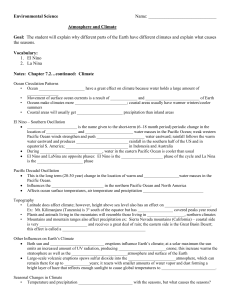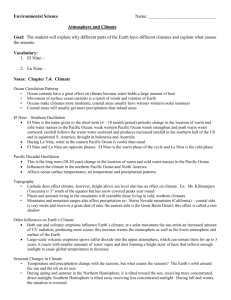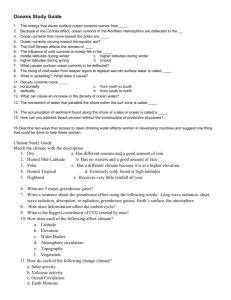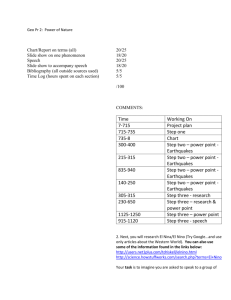Environmental Science Section I Time
advertisement
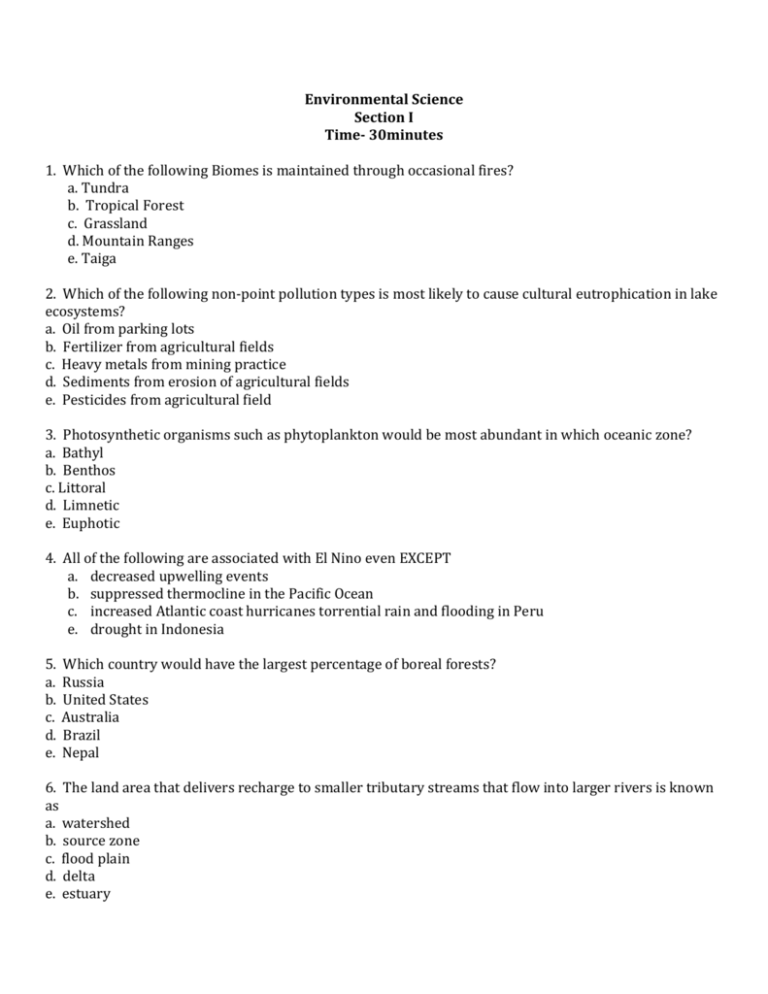
Environmental Science Section I Time- 30minutes 1. Which of the following Biomes is maintained through occasional fires? a. Tundra b. Tropical Forest c. Grassland d. Mountain Ranges e. Taiga 2. Which of the following non-point pollution types is most likely to cause cultural eutrophication in lake ecosystems? a. Oil from parking lots b. Fertilizer from agricultural fields c. Heavy metals from mining practice d. Sediments from erosion of agricultural fields e. Pesticides from agricultural field 3. Photosynthetic organisms such as phytoplankton would be most abundant in which oceanic zone? a. Bathyl b. Benthos c. Littoral d. Limnetic e. Euphotic 4. All of the following are associated with El Nino even EXCEPT a. decreased upwelling events b. suppressed thermocline in the Pacific Ocean c. increased Atlantic coast hurricanes torrential rain and flooding in Peru e. drought in Indonesia 5. a. b. c. d. e. Which country would have the largest percentage of boreal forests? Russia United States Australia Brazil Nepal 6. The land area that delivers recharge to smaller tributary streams that flow into larger rivers is known as a. watershed b. source zone c. flood plain d. delta e. estuary 7. Oceanic currents act as a conveyor belt system creating a connected loop of deep and shallow ocean currents that transfers warm and cold water between the tropics and the poles. The strongest influence on this system of ocean currents is due to a. upwelling events that bring cold nutrient- rich water from the bottom to the top b. the rotation of the earth on its axis c. differences in water density due to temperature and salinity concentrations d. atmospheric convection causing large inputs of freshwater into the ocean by precipitation e. location of continents that help determine direction and flow of ocean currents 8. The most biologically diverse areas of the ocean include coral reefs and estuaries. All of the following characteristics are reasons why these ecosystems can support such a high level of diversity EXCEPT: a. They are areas of high primary productivity b. Both ecosystems have abundant nutrient flow that supports phytoplankton populations. c. Coral reefs and estuaries receive an abundant amount of sunlight d. Both ecosystems provide plenty of habitat space for organisms e. These ecosystems do not have commercially important species; therefore human impact on biodiversity is limited 9. Deep lakes that characterized by steep banks and have a relatively small supply of plant nutrients are known as a. autotropic b. euphotic c. mesotrophic d. oligotrophic e. eutrophic 10. Marine biologists have found that increasing atmospheric carbon dioxide levels are lowering ocean pH, a condition known as ocean acidification. This also causes a decrease in the concentration of calcium carbonate ions. If this rise were to continue it would have a devastating impact on coral ecosystems because a. it would cause a decline in the endosymbiotic algae the coral depend on b. it would decrease the ability of the corals to form their exoskeleton c. it would increase the amount of dissolved oxygen beyond the tolerance of the coral d. it would increase the turbidity of the water beyond the corals’ range of tolerance e. it would decrease the number of crustaceans that act as keystone species in the coral reef ecosystem 11. The direction of the rotation of large cyclones-winds around the center of a cyclone rotate clockwise in the northern hemisphere and counterclockwise in the southern hemisphere-is due to the a. earth’s rotation b. temperature differences in ocean currents c. Coriolis Effect d. Tropical vortex effect e. Uneven heating of the earth by the sun 12. This ecosystem is characterized by long, hot summers and moderate, moist winters. It supports many small mammals, and most vegetation germinates after a period exposed to fire. It is mostly found along coastal areas such as the Pacific coast of North America, south Texas and Mexico, and the coastal hills of Chile and the Mediterranean. a. Tundra b. Desert c. Grassland d. Chapparal e. Taiga forest 13. The area that would receive the most precipitation would be a. A b. B c. C d. D e. E 14. The rain shadow effect would be located at point a. A b. B c. C d. D e. E 15. Of the freshwater on Earth that is not trapped in snow packs or glacier, most of it (95%) is trapped in a. Lakes b. rivers c. aquifiers d. dams e. estuaries, marshes, and bogs 16. The primary use of freshwater is for a. industry b. domestic use c. fishing d. agriculture e. landscaping 17. A mixture of freshwater and saltwater is known as a. brackish water b. gray water c. black water d. connate water e. lentic water 18. Which of the following conditions may indicate an El Nino ? a. sea surface warms, trade winds strengthen b. sea surface warms, trade winds weaken c. sea surface cools, trade winds strengthen d. sea surface cools, trade winds weaken e. None of the above 19. What does La Nino bring to the southeastern United States? a. Warm winters b. Extremely cold winters c. Hot summers d. Cooler than normal summers e. none of the above 20. Which of the following ocean currents flows without obstruction or barriers around Earth a. Gulf Stream b. California Current c. Antartic Circumpolar Current d. Aghulas Current e. They all flow unimpeded. For questions 21-23, choose from the following A. B. C. D. E. Tropical rain forest Temperate deciduous forest Savanna Taiga Tundra 21. Forests of cold climates of high latitudes and high altitudes 22. Warm year –round; prolonged dry seasons; scattered trees 23. Low biodiversity due to lots of shade, which limits food for herbivores, Major resource for timber 24. Whether a land area supports a deciduous forest or grassland depends primarily on a. Changes in temperature b. Latitude north or south of the equator c. Consistency of rainfall from year to year and the effect that it has on fires d. Changes in length of the growing season e. None of the above 25. ENSO takes place at intervals of 2 to 7 years and lasts approximately a. 6 months b. 1 to 2 years c. 3 years d. 2 to 5 years e. 7 years Bonus Questions: Answer at the top of FRQ questions 26. The Coriolis effect is a result of the Earth’s a. Gravitation b. Temperature c. Rotation d. Plant life e. Curvature 27. What is the difference between an El Nino event a La Nina event? a. La Nina involves cool Pacific Ocean surface temperature, while El Nino involves warmer ocean surface temperatures b. El Nino is a milder version of La Nina c. La Nina events occur in the Pacific Ocean, and El Nino events occur in the Atlantic Ocean d. La Nina events occur in the Atlantic Ocean and El nino events decrease temperatures e. La Nina events increase temperatures worldwide, and El Nino events decrease temperatures. 28. Trade winds in the Northern and Southern Hemispheres deflect toward a. The equator b. The poles c. Continental land masses d. The temperate zones e. Higher latitudes 29. If a population doubles in about 70 years, it is showing a _____% growth rate. (A) 1 (B) 5 (C) 35 (D) 140 (E) 200 30. As demographers define it, industrial population growth includes (A) high birthrates and high death rates (B) high birthrates and low death rates (C) low birthrates and high death rates (D) low birthrates and low death rates (E) birthrates and death rates that increase and decrease unpredictably 31. The number of children an average woman would have, assuming that she lives her full reproductive lifetime, is known as the (A) birth rate (B) crude birth rate (C) TFR (D) RLF (E) Zero population growth rate 32. The atmospheric concentration of carbon dioxide increased from 278 ppm in 1790 to 383 ppm in 2007. What is the approximate percent increase in carbon dioxide concentration from 1790 to 2007? (A) 38% (B) 50% (C) 92% (D) 105% (E) 138% 33. What group developed guidelines to help countries create atmospheric inventories across international borders? (A) EPA (B) IPCC (C) NASA (D) CDC (E) USDA 34. Consider the following scenario: The temperature of your skin increases, which leads to an increase in perspiration. Perspiration evaporates from the surface of your skin. The temperature of your skin decreases. This is an example of (A) a positive feedback loop (B) a negative feedback loop (C) syngery (D) a closed sysytem (E) an open system 35. Southeastern Asian flying foxes are responsible for pollinating most durian tree flowers and spreading durian seeds. Durian fruit and durian trees support a vast array of other species, such that a decline in the flying fox population could have disastrous effects for the local ecology. As a result, flying foxes can probably be considered (A) an indicator species (B) an invasive species (C) a keystone species (D) a parasitic species (E) a pioneer species Environmental Science Section II Time- 15 minutes

